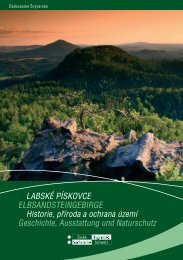ABSTRACT BOOK Sandstone Landscapes ... - Sandstones.org
ABSTRACT BOOK Sandstone Landscapes ... - Sandstones.org
ABSTRACT BOOK Sandstone Landscapes ... - Sandstones.org
You also want an ePaper? Increase the reach of your titles
YUMPU automatically turns print PDFs into web optimized ePapers that Google loves.
TFrederick J. Rumsey 1 , Johannes C. Vogel 1 , Stephen J. Russell 1 , John A.Barrett 2 and Mary Gibby 11 Department of Botany, The Natural History MuseumCromwell Road, London SW7 5BD, United Kingdom(J.Vogel@nhm.ac.uk)Climate, colonisation and celibacy: Phylogeography and population structure inTrichomanes speciosum (Pteridophyta)The Killarney fern Trichomanes speciosum Willd. (Hymenophyllaceae) was first discovered in centralEurope in 1993. The species is unique in possessing both extensive sexual (both generations present) andasexual (gametophytes only present) ranges. T. speciosum is represented in this area by its perennial,vegetatively propagating gametophyte generation. Genetic diversity (allozymes and cpDNA sequencing)has been investigated from throughout the known distribution, including all Macaronesian archipelagos, thewestern Atlantic fringe and Central Europe. Chloroplast DNA sequencing revealed a clear partinioning ofdiversity and suggests different refugia and subsequent colonisation routes of the taxon during thePleistocene.For Central Europe the pattern of allozyme diversity suggests that colonisation was not solely of a“stepping stone” or “leading edge” type. We suggest that during a climatically favourable period, probablythe Atlantic hypsithermal, there may have been an explosive colonisation by long distance dispersal fromglacial refugia. This was followed by a short period during which sporophyte production, sexualreproduction and local spread was possible. With climatic change and the consequent loss of thesporophyte generation individual genets resulting from this process became fixed within small, favourablebut scattered sites. The possibility that some central European sites north of the Alps, especially sandstonemassifs such as the Elbsandsteingebirge, acted as peri-glacial refugia cannot be discounted, but wouldappear less likely than (re-)colonisation from the Atlantic fringe.TVlastimil RůžičkaInstitute of Entomology, Academy of Sciences of the Czech Republic, Branišovská 31, CZ-370 05 ČeskéBudějovice, Czech Republic (vruz@entu-cas.cz)Spiders on sandstone rocks in České Švýcarsko National ParkSpiders on sun-exposed and shaded rock walls in České Švýcarsko NP were collected using hanging boardtraps. A total of 174 spider specimens belonging to 39 species were collected. A half of species collectedwere found exclusively on sun-exposed rocks, a second half exclusively on shaded rocks. The assemblageof sun-exposed rocks is characterised by presence of species with usual or preferential occurrence inThermophyticum and in very dry habitats (Xerolycosa nemoralis, Drassodes lapidosus, Zelotes puritanus,Zelotes petrensis, Aelurillus v-insignitus, Zodarion germanicum, Episinus truncatus). The assemblage ofshaded rocks is characterised by presence of species with usual or preferential occurrence in Mesophyticumand in semi-humid habitats (Nesticus cellulanus, Hahnia pusilla, Amaurobius fenestralis, Callobiusclaustrarius, Harpactea lepida, Cicurina cicur, Histopona torpida).Lepthyphantes pulcher is an exclusive inhabitant of rocks. Zelotes puritanus occurs rare on rocks, rockmargins and adjacent rock steppes and forest steppes. Records in České Švýcarsko NP and Klíč Mt. innorth Bohemia extends its distribution behind borders of Thermophyticum.<strong>Sandstone</strong> rocks are characterised by marked contrast between forested plateau and bare vertical rock wall.The edge with sporadic herb and shrub vegetation is very narrow, but is the case of sun-exposed rocks, isable to harbour specific assemblage of spiders with numerous thermophilous species.




